Hyundai Accent 2006 Owner's Manual
Manufacturer: HYUNDAI, Model Year: 2006, Model line: Accent, Model: Hyundai Accent 2006Pages: 599, PDF Size: 17.59 MB
Page 261 of 599
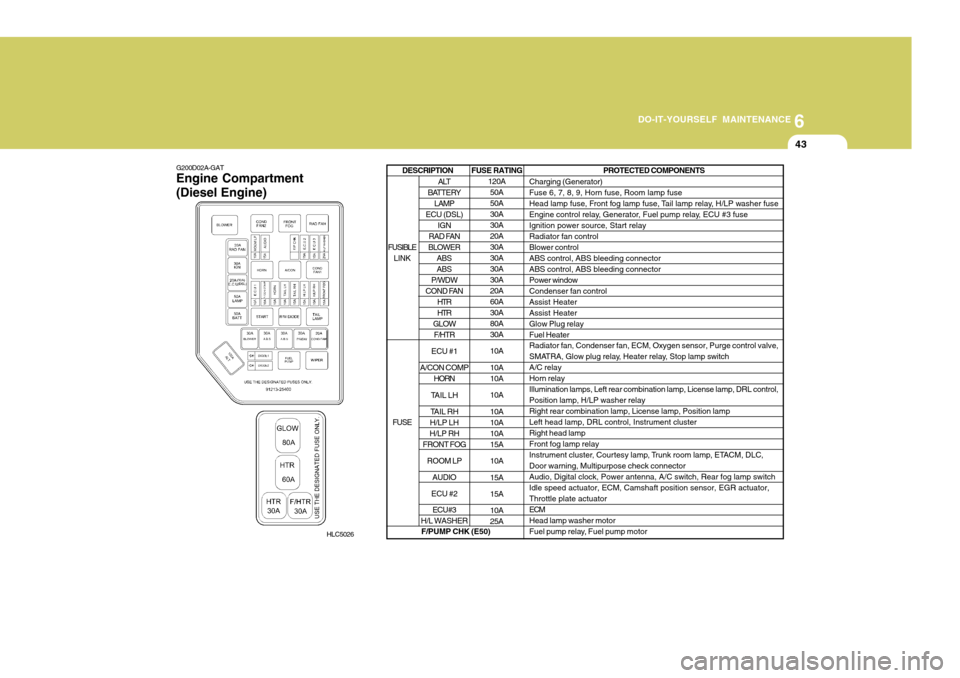
6
DO-IT-YOURSELF MAINTENANCE
43
HLC5026 FUSE RATING
120A50A 50A30A30A20A30A30A30A30A20A60A30A80A30A 10A 10A 10A 10A10A 10A10A15A 10A15A 15A 10A 25A PROTECTED COMPONENTS
Charging (Generator)Fuse 6, 7, 8, 9, Horn fuse, Room lamp fuse
Head lamp fuse, Front fog lamp fuse, Tail lamp relay, H/LP washer fuse
Engine control relay, Generator, Fuel pump relay, ECU #3 fuseIgnition power source, Start relayRadiator fan controlBlower controlABS control, ABS bleeding connectorABS control, ABS bleeding connectorPower windowCondenser fan controlAssist HeaterAssist HeaterGlow Plug relayFuel Heater Radiator fan, Condenser fan, ECM, Oxygen sensor, Purge control valve,
SMATRA, Glow plug relay, Heater relay, Stop lamp switchA/C relayHorn relayIllumination lamps, Left rear combination lamp, License lamp, DRL control,Position lamp, H/LP washer relayRight rear combination lamp, License lamp, Position lampLeft head lamp, DRL control, Instrument clusterRight head lampFront fog lamp relay
Instrument cluster, Courtesy lamp, Trunk room lamp, ETACM, DLC,Door warning, Multipurpose check connectorAudio, Digital clock, Power antenna, A/C switch, Rear fog lamp switchIdle speed actuator, ECM, Camshaft position sensor, EGR actuator,Throttle plate actuatorECMHead lamp washer motor
Fuel pump relay, Fuel pump motor
ALT
BATTERY LAMP
ECU (DSL) IGN
RAD FAN
BLOWER
ABS ABS
P/WDW
COND FAN
HTRHTR
GLOW F/HTR
ECU #1
A/CON COMP HORN
TAIL LH
TAIL RH
H/LP LH
H/LP RH
FRONT FOG
ROOM LP AUDIO
ECU #2 ECU#3
H/L WASHER
FUSIBLE
LINK
FUSEDESCRIPTION
F/PUMP CHK (E50)G200D02A-GAT Engine Compartment (Diesel Engine)
Page 262 of 599
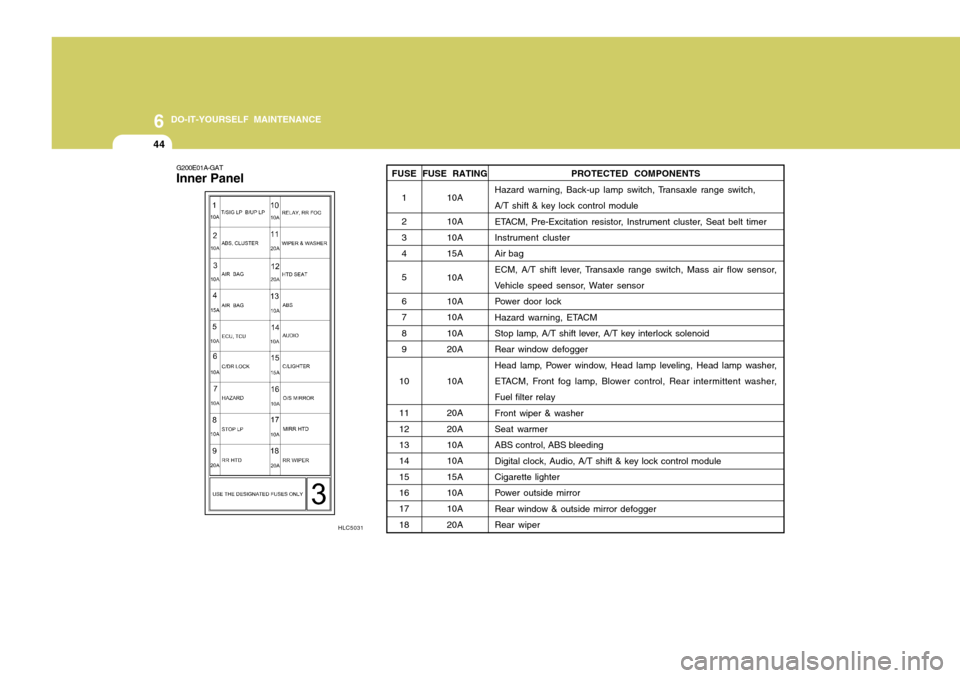
6 DO-IT-YOURSELF MAINTENANCE
44
G200E01A-GAT Inner Panel
HLC5031 PROTECTED COMPONENTS
Hazard warning, Back-up lamp switch, Transaxle range switch, A/T shift & key lock control module
ETACM, Pre-Excitation resistor, Instrument cluster, Seat belt timer Instrument cluster Air bag
ECM, A/T shift lever, Transaxle range switch, Mass air flow sensor,
Vehicle speed sensor, Water sensor
Power door lock
Hazard warning, ETACM
Stop lamp, A/T shift lever, A/T key interlock solenoid Rear window defogger
Head lamp, Power window, Head lamp leveling, Head lamp washer,
ETACM, Front fog lamp, Blower control, Rear intermittent washer, Fuel filter relayFront wiper & washer Seat warmer ABS control, ABS bleedingDigital clock, Audio, A/T shift & key lock control module Cigarette lighter
Power outside mirrorRear window & outside mirror defogger Rear wiper
FUSE RATING
10A 10A 10A15A 10A10A 10A 10A20A 10A20A 20A10A 10A 15A10A 10A 20A
FUSE
1 2 3 4 56 78 9
10 11 12 13 1415 16 1718
Page 263 of 599
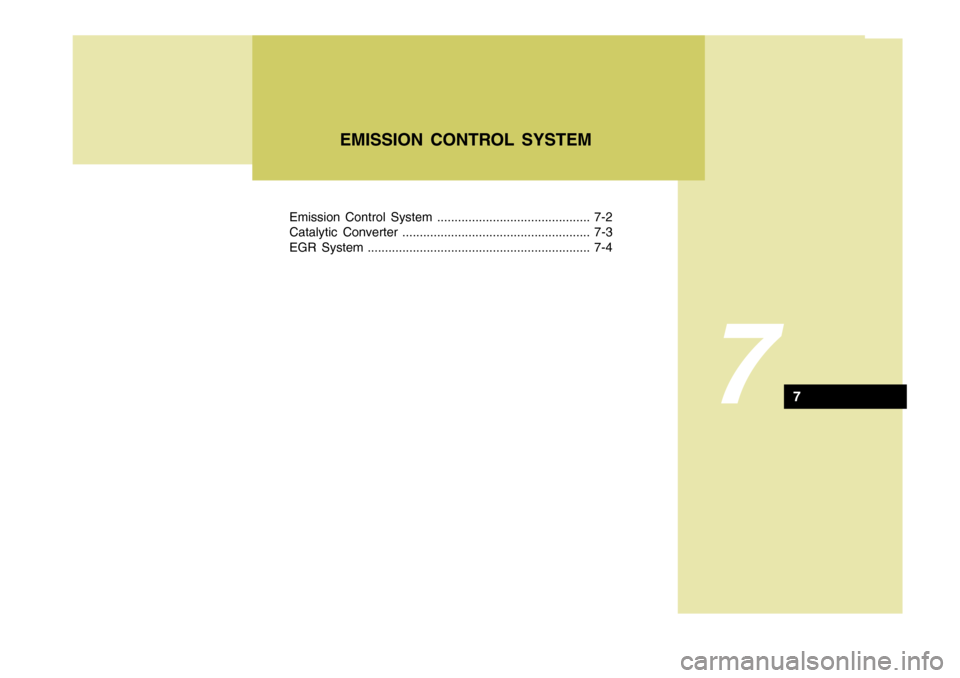
Emission Control System ............................................ 7-2
Catalytic Converter ...................................................... 7-3
EGR System ................................................................ 7-4
7
EMISSION CONTROL SYSTEM
7
Page 264 of 599
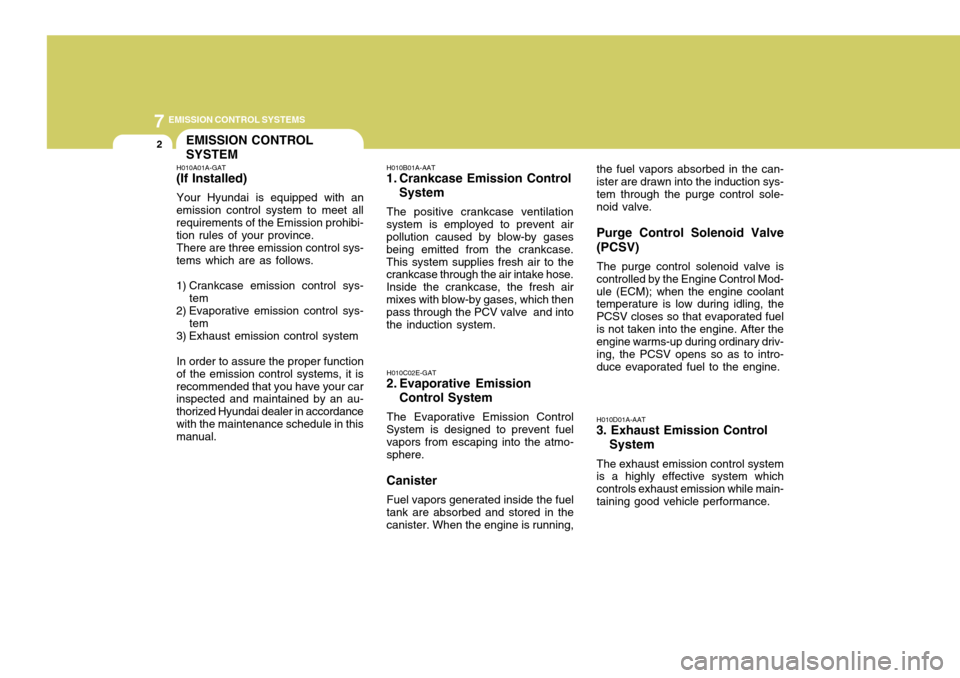
7EMISSION CONTROL SYSTEMS
2EMISSION CONTROL SYSTEM
H010A01A-GAT
(If Installed)
Your Hyundai is equipped with an
emission control system to meet all requirements of the Emission prohibi- tion rules of your province. There are three emission control sys-
tems which are as follows.
1) Crankcase emission control sys- tem
2) Evaporative emission control sys-
tem
3) Exhaust emission control system
In order to assure the proper function
of the emission control systems, it is recommended that you have your car inspected and maintained by an au- thorized Hyundai dealer in accordancewith the maintenance schedule in this manual. H010B01A-AAT
1. Crankcase Emission Control
System
The positive crankcase ventilation
system is employed to prevent airpollution caused by blow-by gases being emitted from the crankcase.This system supplies fresh air to the crankcase through the air intake hose. Inside the crankcase, the fresh airmixes with blow-by gases, which then pass through the PCV valve and into the induction system.
H010C02E-GAT
2. Evaporative Emission
Control System
The Evaporative Emission Control
System is designed to prevent fuelvapors from escaping into the atmo-sphere. Canister
Fuel vapors generated inside the fuel
tank are absorbed and stored in the canister. When the engine is running, the fuel vapors absorbed in the can-ister are drawn into the induction sys-tem through the purge control sole- noid valve. Purge Control Solenoid Valve (PCSV)
The purge control solenoid valve is
controlled by the Engine Control Mod- ule (ECM); when the engine coolant temperature is low during idling, the PCSV closes so that evaporated fuelis not taken into the engine. After the engine warms-up during ordinary driv- ing, the PCSV opens so as to intro-duce evaporated fuel to the engine. H010D01A-AAT
3. Exhaust Emission Control
System
The exhaust emission control system is a highly effective system which controls exhaust emission while main-taining good vehicle performance.
Page 265 of 599
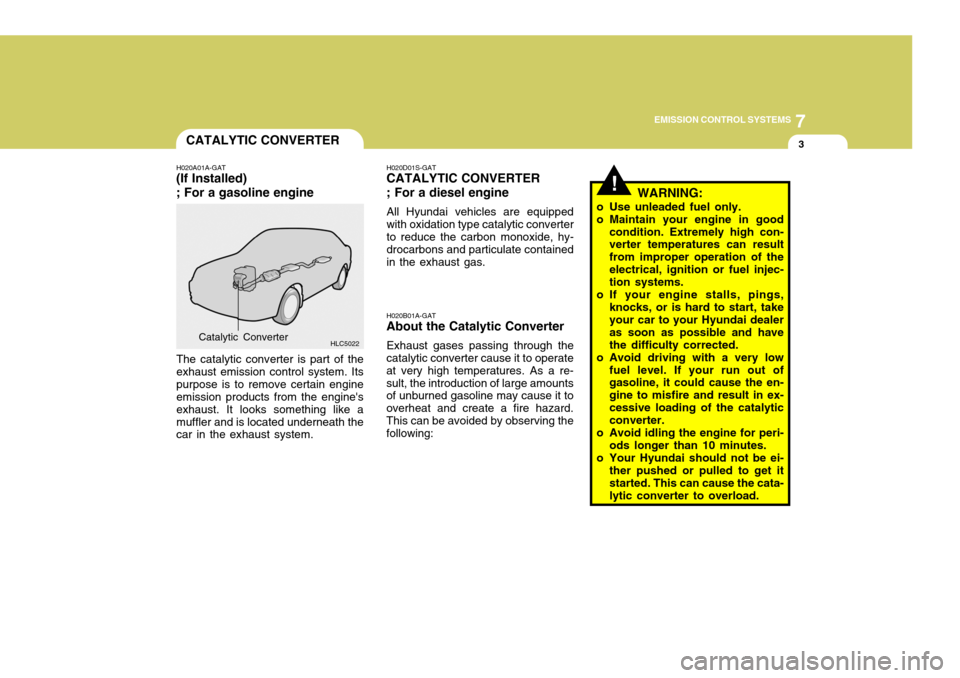
7
EMISSION CONTROL SYSTEMS
3
!
CATALYTIC CONVERTER
H020A01A-GAT
(If Installed) ; For a gasoline engine
HLC5022
The catalytic converter is part of the exhaust emission control system. Itspurpose is to remove certain engine emission products from the engine's exhaust. It looks something like amuffler and is located underneath the car in the exhaust system.
Catalytic Converter H020B01A-GAT
About the Catalytic Converter
Exhaust gases passing through the
catalytic converter cause it to operate at very high temperatures. As a re-sult, the introduction of large amounts of unburned gasoline may cause it to overheat and create a fire hazard.This can be avoided by observing the following: H020D01S-GAT CATALYTIC CONVERTER ; For a diesel engine All Hyundai vehicles are equipped with oxidation type catalytic converter to reduce the carbon monoxide, hy- drocarbons and particulate containedin the exhaust gas.
WARNING:
o Use unleaded fuel only.
o Maintain your engine in good condition. Extremely high con- verter temperatures can result from improper operation of theelectrical, ignition or fuel injec- tion systems.
o If your engine stalls, pings, knocks, or is hard to start, takeyour car to your Hyundai dealer as soon as possible and havethe difficulty corrected.
o Avoid driving with a very low fuel level. If your run out of gasoline, it could cause the en- gine to misfire and result in ex-cessive loading of the catalytic converter.
o Avoid idling the engine for peri- ods longer than 10 minutes.
o Your Hyundai should not be ei- ther pushed or pulled to get itstarted. This can cause the cata- lytic converter to overload.
Page 266 of 599
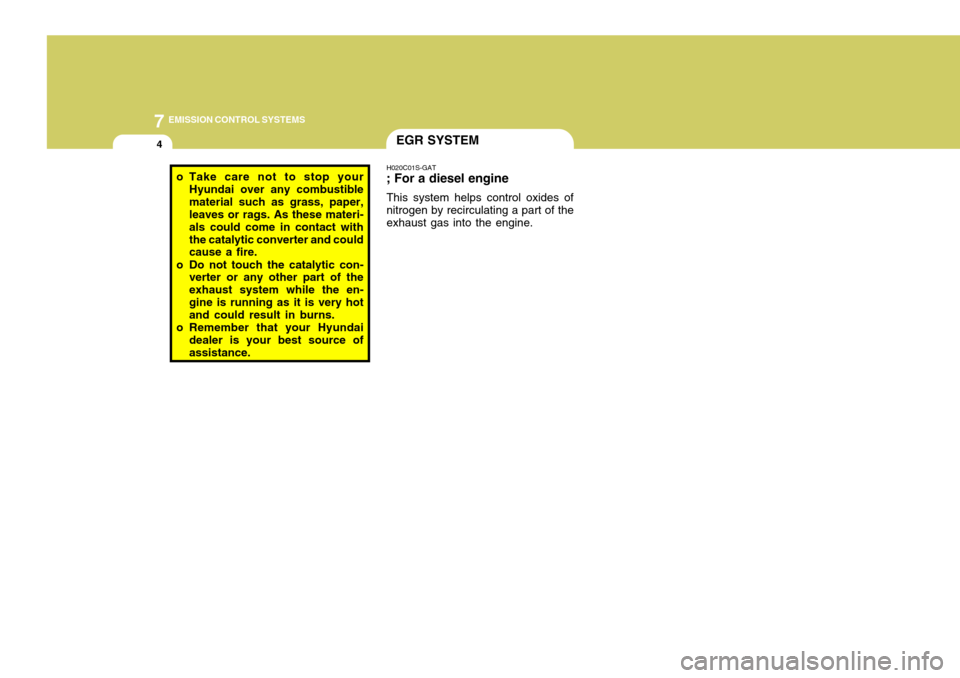
7EMISSION CONTROL SYSTEMS
4EGR SYSTEM
H020C01S-GAT
; For a diesel engine
This system helps control oxides of nitrogen by recirculating a part of the exhaust gas into the engine.
o Take care not to stop your
Hyundai over any combustible material such as grass, paper, leaves or rags. As these materi- als could come in contact withthe catalytic converter and could cause a fire.
o Do not touch the catalytic con- verter or any other part of the exhaust system while the en-gine is running as it is very hot and could result in burns.
o Remember that your Hyundai dealer is your best source ofassistance.
Page 267 of 599
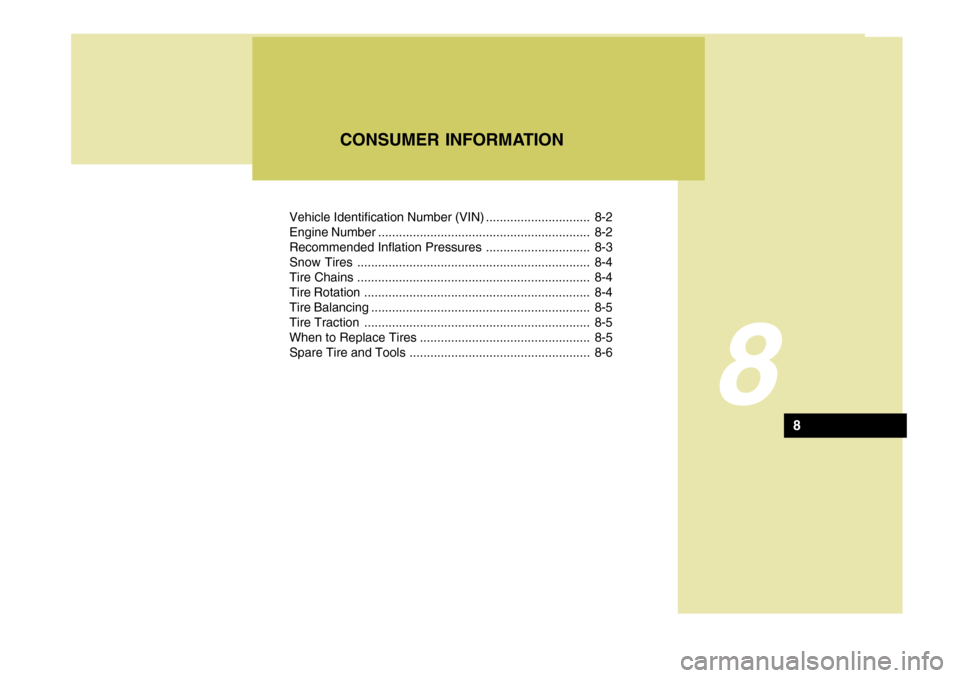
Vehicle Identification Number (VIN) .............................. 8-2
Engine Number ............................................................. 8-2
Recommended Inflation Pressures .............................. 8-3
Snow Tires ................................................................... 8-4
Tire Chains ................................................................... 8-4
Tire Rotation ................................................................. 8-4
Tire Balancing ............................................................... 8-5
Tire Traction ................................................................. 8-5
When to Replace Tires ................................................. 8-5
Spare Tire and Tools .................................................... 8-6
8
CONSUMER INFORMATION
8
Page 268 of 599
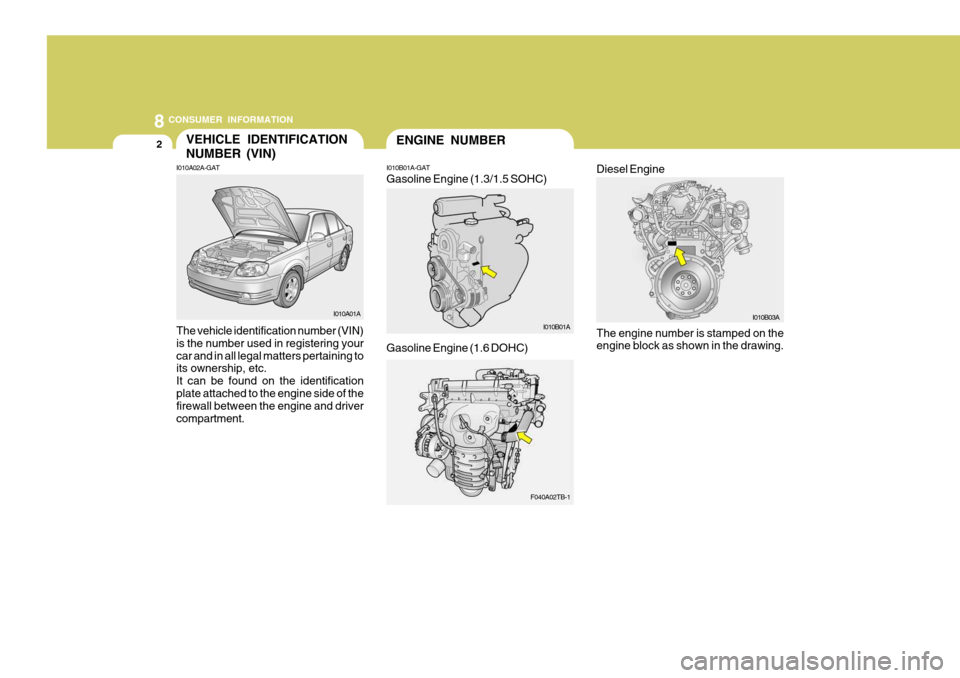
8CONSUMER INFORMATION
2VEHICLE IDENTIFICATION NUMBER (VIN)ENGINE NUMBER
I010A01A
I010B01A
I010A02A-GAT The vehicle identification number (VIN) is the number used in registering yourcar and in all legal matters pertaining to its ownership, etc. It can be found on the identificationplate attached to the engine side of the firewall between the engine and driver compartment. I010B01A-GAT
The engine number is stamped on the engine block as shown in the drawing.
Gasoline Engine (1.3/1.5 SOHC)
F040A02TB-1
Gasoline Engine (1.6 DOHC)
I010B03A
Diesel Engine
Page 269 of 599

8
CONSUMER INFORMATION
3
UP TO
MAX. LOAD
UP TO
PERSONSTIRE
I020A01A-AAT TIRE INFORMATION The tires supplied on your new Hyundai are chosen to provide the best perfor-mance for normal driving. I030A03A-GAT RECOMMENDED INFLATION PRESSURES The tire label located in the glove box gives the tire pressures recommended for your car. These pressures were chosen to pro-vide the most satisfactory combinationof ride comfort, tire wear and stability under normal conditions. Tire pres- sures should be checked at leastmonthly. Proper tire inflation pressures should be maintained for these rea- sons:
o Lower-than-recommended tire pres-
sures cause uneven tread wear and poor handling.
o Higher-than-recommended tire
pressures increase the chance ofdamage from impacts and cause uneven tread wear.
I030A01A CAUTION:
Always observe the following:
o Check pressures when the tires are cold. That is, after the car has been parked for at least threehours and hasn't been driven more than 1.6 km or one mile since starting up.
o Check the pressure of your spare tire each time you check the pres-sure of other tires.
o Never overload your vehicle. Be
especially careful about overload- ing if you equip your vehicle witha luggage rack.
o Worn, old tires can cause acci- dents. If your tread is badly worn,or if your tires have been dam-aged, replace them.
!
5Jx13 5Jx145Jx135Jx14 175/70R13185/60R14175/70R13185/60R14 FRONT
230(33) 230(33) REAR
230(33) 230(33)
FRONT 207(30) 220(32)
Gas- olineDie-sel
TIRE
SIZE
RIM
SIZE PRESSURE, kPa (PSI)EN-
GINE
REAR
207(30) 207(30)
Page 270 of 599
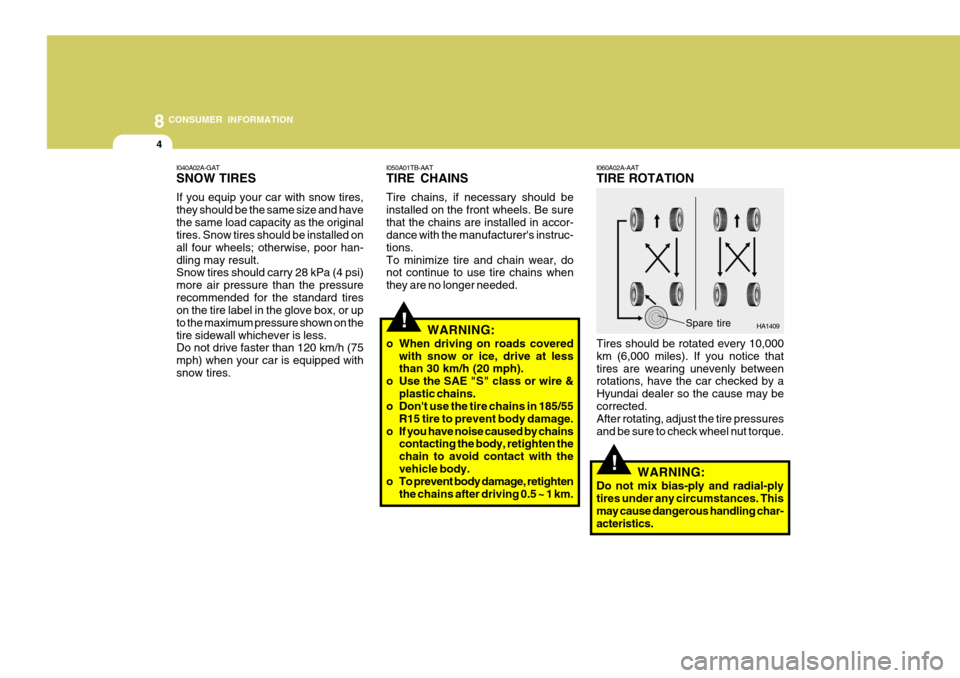
8CONSUMER INFORMATION
4
!
!
I050A01TB-AAT TIRE CHAINS Tire chains, if necessary should be installed on the front wheels. Be surethat the chains are installed in accor- dance with the manufacturer's instruc- tions.To minimize tire and chain wear, do not continue to use tire chains when they are no longer needed.
I040A02A-GAT SNOW TIRES If you equip your car with snow tires, they should be the same size and havethe same load capacity as the original tires. Snow tires should be installed on all four wheels; otherwise, poor han-dling may result. Snow tires should carry 28 kPa (4 psi) more air pressure than the pressurerecommended for the standard tires on the tire label in the glove box, or up to the maximum pressure shown on thetire sidewall whichever is less. Do not drive faster than 120 km/h (75 mph) when your car is equipped withsnow tires. I060A02A-AAT TIRE ROTATION
Tires should be rotated every 10,000 km (6,000 miles). If you notice thattires are wearing unevenly between rotations, have the car checked by a Hyundai dealer so the cause may becorrected. After rotating, adjust the tire pressures and be sure to check wheel nut torque.
WARNING:
o When driving on roads covered with snow or ice, drive at less than 30 km/h (20 mph).
o Use the SAE "S" class or wire & plastic chains.
o Don't use the tire chains in 185/55
R15 tire to prevent body damage.
o If you have noise caused by chains contacting the body, retighten the chain to avoid contact with thevehicle body.
o To prevent body damage, retighten
the chains after driving 0.5 ~ 1 km. HA1409
Spare tire
WARNING:
Do not mix bias-ply and radial-ply tires under any circumstances. Thismay cause dangerous handling char- acteristics.